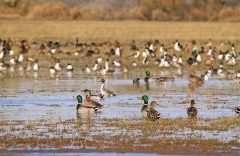A Vital Home for Fish and Wildlife
By Duane Hovorka, IWLA Agriculture Program Director • Excerpted from "Outdoor America" 2021 issue #2
 Prairie potholes like this one in North Dakota rovide essential breeding grounds for migrating birds and other wildlife.
Prairie potholes like this one in North Dakota rovide essential breeding grounds for migrating birds and other wildlife.
Growing up a city kid in Nebraska, I was lucky to spend many a holiday on my grandparents’ farm in southwest Nebraska or the farms my uncles and aunts operated in South Dakota. If you were a careful observer, you could spot rabbits in the woodlands, pheasants in the fields, deer in the pasture and the occasional rattlesnake down by the irrigation canal where mom told us not to go.
America’s farms and ranches have always provided important habitat for our fish and wildlife. More than 40 percent of the United States is privately owned farm and ranch land, totaling more than 900 million acres. In states like Illinois, Iowa, Kansas, Nebraska, Oklahoma and Texas, farms and ranches make up more than 75 percent of the land base, compared to less than five percent set aside as public parks, refuges and wildlife areas.
About 85 percent of hunters in the U.S. hunt privately owned land, much of it on farms and ranches. There they find a wide variety of game species: deer, elk, turkey, quail, ducks, geese, pheasants and many more.
About half of the wildlife species on the U.S. Fish and Wildlife Service threatened and endangered list depend heavily
on private land, much of it farms and ranches. That land is home to most of the wetlands in the Prairie Pothole Region of the northern Great Plains, dubbed “America’s Duck Factory.” But these small ponds and wetlands are also breeding grounds and stopover areas for more than 60 percent of the migratory bird species in the U.S.
Loss of Habitat = Loss of Wildlife
Our grassland birds are in sharp decline, largely the result of lost habitat. Millions of acres of grassland have been converted to cropland. Some remaining grasslands have been degraded by overgrazing and poor management. Fish and
amphibians have also suffered as wetlands have been drained and filled, and waterways of all kinds grow more polluted by fertilizer, pesticides and manure.
The implications are clear. To have healthy fish and wildlife populations we cannot focus only on our national and state parks, refuges and wildlife areas. We need to expand programs that help landowners make a place for wildlife on their farms and ranches and better protect our streams, lakes and wetlands.
The League Seeks Solutions
The Izaak Walton League of America is a strong supporter of the Recovering America’s Wildlife Act, which was introduced in Congress in April. This bill would provide states and tribes $1.4 billion annually to restore essential habitat and implement conservation strategies outlined in each state’s Wildlife Action Plan. Those state plans focus in part on restoring and protecting wildlife habitat on farms and ranches.
The 2018 Farm Bill provides $6 billion per year to help farmers and ranchers adopt conservation practices, including many that provide habitat for birds, mammals and pollinators. About $2 billion of that supports the Conservation Reserve Program (CRP), which rewards landowners who set aside environmentally sensitive farmland. That program now provides 21 million acres of grassland and wetland habitat. That supports a variety of wildlife, boosting the duck population by about 2 million per year, increasing pheasant numbers by 22 percent and providing much-needed habitat for pollinators like bees and monarch butterflies.
The CRP has also prevented more than nine billion tons of soil from eroding and provided buffer strips to protect 170,000 miles of streams. The program also stores an average of 49 million tons of greenhouse gases in the soil each year.
The Farm Bill’s conservation easement program has restored several million acres of wetlands and provided permanent protection to more than five million acres of grasslands, wetlands and other farmland.
All told, the U.S. Department of Agriculture’s (USDA) major working lands programs have helped landowners improve the management of their grasslands, adopt wildlife-friendly farming practices and better manage their woodlands.
Climate-friendly is Wildlife-friendly
This year, Congress is considering a variety of bills to address climate change. That could provide an opportunity to double funding for USDA’s suite of conservation programs because many of the practices that benefit fish and wildlife also address climate change.
Restoring and better managing grasslands and woodlands will reduce greenhouse gas emissions and store carbon in the soil and in trees. Providing permanent protection for wetlands, grasslands and woodlands will keep the carbon stored there for decades to come.
By expanding USDA conservation programs that have a long record of success, Congress could promote climate-friendly agriculture while doing more to make a place for fish and wildlife on America’s farms and ranches.
Over the past century, America has done much to restore to the landscape the species that we hunt and fish. But many other species are in trouble.
For the century ahead, we must expand programs that conserve land and water and help make a place for wildlife on farms and ranches for the generations to come.